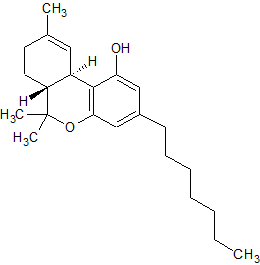On Cannabinoids in General
Cannabinoids are the substances that cause most of the physical and psychological changes in consumers when ingesting cannabis. In other words, they are the principle active ingredients in the plant.
The two main cannabinoids on the recreational and medicinal cannabis market have traditionally been delta-9-tetrahydrocannabinol (THC) and cannabidiol (CBD). Each of these interacts in its own way with cannabinoid receptors in our bodies, reactions whose strength is largely determined by the length of the alkyl-side chain on the molecule, or the length of the carbon chain.
THCP: A New Cannabinoid
In Italy in 2019, a team of scientists isolated a new phytocannabinoid called delta-9-tetrahydrocannabiphorol (THCP) from an Italian cannabis cultivar called FM2. [1] The raw biomass was extracted with 96% ethanol or hexane. Preparative liquid chromatography was then used to isolate and purify THCP.
THCP has a seven-link carbon chain, Prior to its discovery, there were no naturally occurring cannabinoids with carbon chains that long (only synthetic molecules were known). This seven-link chain is longer than THC’s five-link chain, meaning THCP’s psychoactive effects are more potent than the ones caused by THC. The Italian researchers state the potency of THCP may be 33x stronger than THC and 63 times more active than tetrahydrocannabivarin (THCV).
Dosing
Although they did not perform any tests on humans, the researchers did administer THCP to mice. Their reaction to THCP mimicked their reaction to THC. Test subjects experienced catalepsy, body temperature reduction, and hypomotility (deficiency of movement), thereby demonstrating the properties of traditional cannabinoid receptor 1 (CB1) agonists. A dose of 5 mg/kg of body weight of THCP produced similar affects to a 10 mg/kg dose of THC.
CBDP
During their efforts to isolate THCP, the research team also isolated cannabidiphorol or CBDP. It also has a seven-link chain. The team did not conduct research on CBDP, but they plan to do so with ongoing studies.
The researchers speculated that other cultivars may contain even more THCP than their chosen plant to study, and they pointed to differences in consumer experiences for products with identical THC contents as potentially coming from THCP and other molecules like it.
Ultimately the research team concluded that “up to now, nobody has ever searched for this potent phytocannabinoid in medicinal cannabis varieties. In our opinion, this compound should be included in the list of the main phytocannabinoids to be determined for a correct evaluation of the pharmacological effect of the cannabis extracts administered to patients. In fact, we believe that the discovery of an extremely potent THC-like phytocannabinoid may shed light on several pharmacological effects not ascribable solely to Δ9-THC.”
Image Source: https://upload.wikimedia.org/wikipedia/commons/7/73/Tetrahydrocannabiphorol.png
References
[1] Citti C, Linciano P, Russo F, et al. A novel phytocannabinoid isolated from Cannabis sativa L. with an in vivo cannabimimetic activity higher thanΔ9-tetrahydrocannabinol:Δ9-Tetrahydrocannabiphorol. Sci Rep. 2019;9(1):20335. [journal impact factor = 4.379; times cited = 71]








